标签:
首先说明一下,即使不熟悉fis3,阅读文本应该也会有所收获。
本文以fis-parser-imweb-tplv2插件为模板插件,目的不在于使用哪个模板,而是组件可视化的实现思路,不必担心。
首先说明一下,我们的项目使用的fis3自带的mod.js做模块化开发。
fis-parser-imweb-tplv2插件是同事在imweb待着的时候写的。模板使用和jsp写法一致,文件类型为tpl类型
<div class="tips"> <em> <i class="triangle"></i> <a class="close" href="javascript:void(0)" title="关闭"></a> </em> <strong><%=content%></strong> <a href=<%=linkUrl%> title=<%=linkTxt%> target="<%=target%>"> <%=linkTxt%> ></a> </div>
实现源码也比较简单易懂。fis3的配置
.match(/\/(.+)\.tpl$/, { // js 模版一律用 .tpl 作为后缀
isMod: true,
rExt: ‘js‘,
id: ‘$1.tpl‘,
url: ‘$0.tpl‘,
moduleId: ‘$1.tpl‘,
release: ‘$0.tpl‘, // 发布的后的文件名,避免和同目录下的 js 冲突
parser: fis.plugin(‘imweb-tplv2‘)
})
最终生成的模块化的.tpl.js文件如下
define(‘common/module/rightsideBar/rightsideBar.tpl‘, function(require, exports, module) { return function (it, opt) { it = it || {}; with(it) { var _$out_= []; _$out_.push(‘<div class="right-sidebar"><a href="javascript:void(0)" class="right-sidebar-unregistered-close"></a><a id="rsidereg" href="/register.html?channel=pcgwzc3" class="right-sidebar-unregistered" style="visibility:‘, (isLogin ?‘hidden‘ :‘visible‘), ‘"><span class="right-sidebar-unregistered-content"></span></a><a href="http://wpa.b.qq.com/cgi/wpa.php?ln=2&uin=4008225538" class="right-sidebar-item right-sidebar-item3" target="_blank"><span class="right-sidebar-item1-content"></span></a><a href="javascript:void(0)" class="right-sidebar-item right-sidebar-item2"><span class="right-sidebar-item2-content"></span><div class="right-sidebar-item-tip--code"> <img src="‘, ‘/static/pc-dev/common/module/topBar/top_wx.png‘, ‘"> <i class="right-sidebar-item-tip--code-tri"><i></i></i></div></a><a href="javascript:void(0)" class="right-sidebar-item right-sidebar-item3"><span class="right-sidebar-item3-content"></span><div class="right-sidebar-item-tip--code"> <img src="‘, ‘/static/pc-dev/common/module/topBar/top_app.png‘, ‘"> <i class="right-sidebar-item-tip--code-tri"><i></i></i></div></a><a href="javascript:void(0)" id="rjsq" class="right-sidebar-item right-sidebar-item4" target="_blank"><span class="right-sidebar-item4-content"></span></a><a href="javascript:window.scrollTo(0,0)" class="right-sidebar-item right-sidebar-item5" style="display: none;"><span class="right-sidebar-item5-content"></span></a></div>‘); return _$out_.join(‘‘); } } });
fis3打包前和打包后的文件结构更改

使用也比较简单
var tpl_rightsideBar = require(‘rightsideBar.tpl‘); tpl_rightsideBar(opt);//opt是需要传递进去的对象。详细查看rightsideBar.tpl.js的源码对应的it参数
当然,我们封装一个组件不可能直接去使用这个tpl。而是提供一个外部组件函数,然后传递参数到这个组件函数中,组件函数不仅渲染页面(即插入组件dom),还处理相关的逻辑。如上面的rightsideBar.js就是为外部提供一个组件函数。rightsideBar组件比较简单,只需要传递一个父节点即可,不需要其他外部数据来做处理。部分源码
/** * @author chua * @date 2016-5-9 * @description 首页右侧导航栏组件,依赖模版 rightsideBar.tpl,rightsideBar.scss; * @实例化:rightsideBar = new rightsideBar(dom, datas); * @param dom {Dom} 为头部组件父级节点,将根据情况append模版,生成头部节点; * @param datas {json} 初始化组件的数据,数据格式如下 */ /* * @require ‘./rightsideBar.scss‘; */ var tpl_rightsideBar = require(‘./rightsideBar.tpl‘); function rightsideBar(cont,opt) { this.cont = $(cont); this.opt = opt; this.init(); }; rightsideBar.prototype.renderHTML = function() { //渲染前处理... this.cont.empty().append(tpl_rightsideBar(this.opt)); }; rightsideBar.prototype.bindEvent = function() { //绑定事件 this.cont.on(‘click‘, ‘.xxx‘, function() { //处理内容... }); }; rightsideBar.prototype.init = function() { this.renderHTML(); this.bindEvent(); } return rightsideBar;
rightsideBar.js会被当做模块来编译(我们在fis-conf.js中配置的),最终编译出来后外面会被define包裹。
define(‘common/module/rightsideBar/rightsideBar‘, function(require, exports, module) { //代码正文 ... rightsideBar.prototype.init = function() { this.renderHTML(); this.bindEvent(); } return rightsideBar; });
使用方法也比较简单
html: <div class="js-rightsideBar"></div> js: var rightsideBar = require(‘/common/module/rightsideBar/rightsideBar.js‘); new rightsideBar($(‘.js-rightsideBar‘));
而我们的所有组件都放在一个组件文件夹module中,每一个组件一个文件夹(当然页可以是多个类似的组件放在一起,公用资源),文件夹下面放置所有这个组件相关的资源。如上图rightsideBar这个组件。
那么如何做组件可视化?有几个过程是必须要做的
1.需要遍历module中所有的组件(即遍历每一个组件下面的.js文件,一个组件文件夹下有多个js文件,表明这个组件文件夹下有多个组件,只是为了公用组件资源才放在了同一个组件下),提取出其中的使用样例(从注释代码中提取,所以必须要规定这段demo代码的规则)。
2.必须在每一个组件的注释中写demo代码。
3.将提取的demo代码写入指定的组件可视化文件中,随fis编译成目标文件(最终在网上打开这个文件就能预览各个组件的demo了)。
在上面的基础上,改如何实现组价的可视化?
第一阶段的组件可视化使用node+fis的方式实现。原理是在fis编译之前使用node执行一个脚本,这个脚本完成遍历组件、提取demo代码、生成组件可视化目标文件。然后在使用fis编译打包,启动服务后在网上访问即可。之所以第一阶段这么做的原因有两点:鄙人比较熟悉node但是对fis插件编写不太熟悉,不敢确定使用fis插件方式是否可行;其次上头希望能在短期内能看到一定效果。先看一下工程结构目录,v_components文件夹里包含了所有用来生成组件可视化文件的工具文件,node执行脚本为index.js
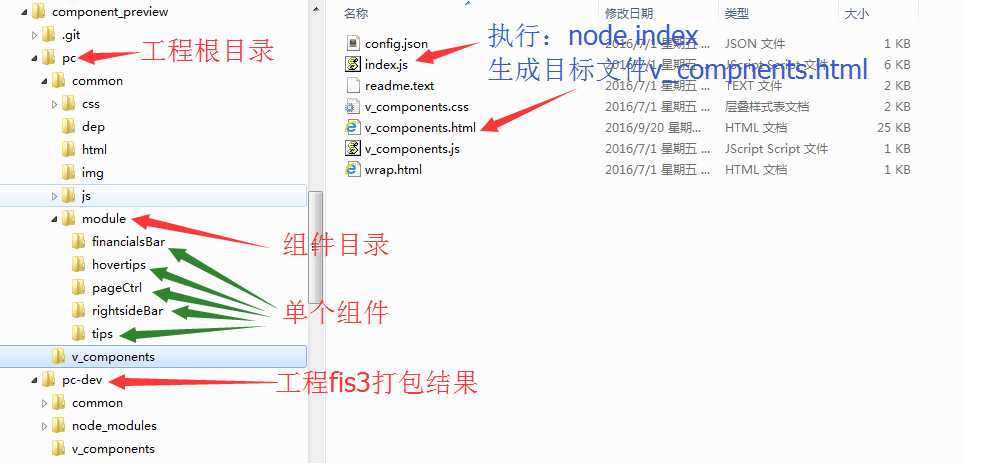
工程源文件点击这里
实现步骤:
1.规定文件注释代码中"@example"和"@example end"之间的字符串被认为是组件demo代码。
/** * @author chua * @date 2016-5-9 * @description 首页右侧导航栏组件,依赖模版 rightsideBar.tpl,rightsideBar.scss;基于jQuery和jquery.cookie.js * @实例化:rightsideBar = new rightsideBar(dom, datas); * @param dom {Dom} 为头部组件父级节点,将根据情况append模版,生成头部节点; * @param datas {json} 初始化组件的数据,数据格式如下 * * @example html: <div class="js-rightsideBar"></div> js: var rightsideBar = require(‘/common/module/rightsideBar/rightsideBar.js‘); new rightsideBar($(‘.js-rightsideBar‘)); @example end */
其中html:后面跟着的是html代码,js:后面跟着的是js执行代码。注意不要出现不符合代码格式的字符,"html:"、"js:"分别为html代码段和js代码段开始的标志。其后的代码分别要严格按照html和js的格式要求书写
2.为了简化和配置更加灵活。我添加了config.json和wrap.html两个文件来配合主文件index.js文件。
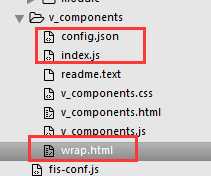
其中index.js文件作用是作为node脚本运行,最终生成最新的v_components.html。v_components.css和v_components.js是给v_component.html使用的,毕竟组件可视化需要一些展示和交互
config.json的作用是希望能够配置组件的一些属性,让其更灵活,移植性更加。目前只支持一个配置:组件的目录 (建议使用相对路径,否则在index.js中可能找不到)
{ "modulePath": "../common/module/" }
warp.html是用来生成v_components.html的模板文件。里面包含了v_components.html文件需要的样式文件和脚本文件。这个文件也是根据实际情况配置
<!DOCTYPE html> <html> <head> <title>组件可视化</title> <link rel="import" href="/common/html/meta.html?__inline"> <link rel="stylesheet" type="text/css" href="/common/css/common.scss" /> <link rel="stylesheet" type="text/css" href="v_components.css" /> <script type="text/javascript" src="/common/dep/mod.js" data-loader></script> <script type="text/javascript" src="/common/dep/jquery.js" data-loader></script> <script type="text/javascript" src="/common/js/common.js" data-loader></script> <script type="text/javascript" src="v_components.js" data-loader></script> </head> <body> </body> </html>
3.主程序index.js读取配置文件config.json中配置的组件目录遍历每一个组件(里面的js文件),提取注释中的demo代码,以wrap.html为模板,将html代码插入为节点,将js脚本插入到script节点中。

var fs = require(‘fs‘); ... var writerStream = fs.createWriteStream(‘v_components.html‘); var regs = { ‘wraphtml‘: /^([\s\S]*<(body)>[\s\S]*)(<\/\2>[\s\S]*)$/, //懒惰匹配到第一个*/ ‘example‘: /\/\*\*([\s\S]*)@example[\s\S]*?html:([\s\S]*?)js:([\s\S]*?)@example end([\s|\S]*?)\*\//,//懒惰匹配第一个*/ ... }; fs.readFile(‘config.json‘, function(err, data){ ... root = obj.modulePath; if(datas){ loopModule(); } }) fs.readFile(‘wrap.html‘, function(err, data){ ... datas = data.toString(); if(root){ loopModule(); } }); //遍历所有模块文件 function loopModule(){ fs.readdir(root, function(err, ffiles){ ... //遍历所有组件 ffiles.forEach(function(ffile){ ... fs.readdir(root + ffile, function (err, files){ ... files.forEach(function(file){//处理每一个模块文件中的模块并找到组件主文件(js文件) if(regs.jsfile.test(file)){ ... fs.readFile(pa, function(err, data){ ... if(match = data.toString().match(regs.example)){//匹配demo代码段 //截取相关信息并添加相关节点 ... innerRightT += ‘<div class="right-side-top-item‘ + (count == 0? ‘ visible‘: ‘‘) + ‘" data-mod="‘+ file +‘">‘ + match[2] + ‘</div>‘; innerJs += match[3] + ";";//js脚本都放在innerJs中 count++; } if(subModLeng == 0){//处理完所有子模块才能说明处理完了整个模块文件夹 unDomoduleLength--; } if(unDomoduleLength == 0){//处理完所有的模块后,最后写入文件 var innerBody = warpText(innerLeftWrap, innerLeft) + warpText(innerRightWrap, warpText(innerRightTWrap, innerRightT) + warpText(innerRightBWrap, innerRightB)) + warpText(jsWrap, innerJs); //使用utf8编码写入数据 writerStream.write(datas.replace(regs.wraphtml, ‘$1‘ + innerBody + ‘$3‘), ‘UTF8‘); //标记文件结尾 writerStream.end(); } }); } }) }); }) }) } //用数组wrapArr包裹inner并返回包裹结果 function warpText(wrapArr, inner){...} //将str字符串转换成HTML格式 function transToHtml(str){...}
最终在v_components目录下执行:node index
生成v_components.html文件
在pc目录下fis3编译:fis3 release dev
在和pc同级的目录下面生成pc-dev文件夹
在pc-dev目录下执行:node server
打开浏览器访问:http://localhost:3000/v_components/v_components.html
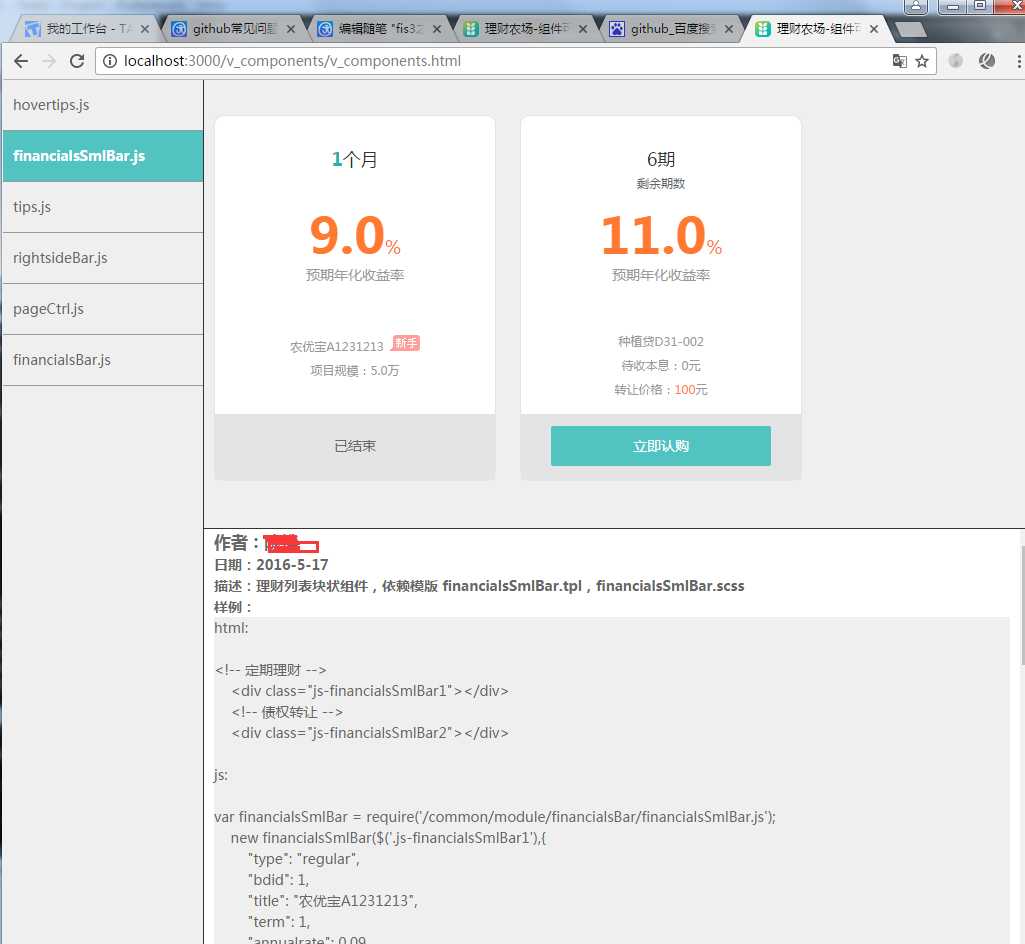
左侧是所有的组件的列表,点击之能看到每一个组件的展示效果。我很丑,但是我很有内涵
之前说过要将组件可视化做成fis插件,随fis编译一起编译打包,不用在手动执行node生成相应文件。主要面临的问题是:如何让组件更加通用?这里面几个需要考虑的点
1.如何从组件代码的注释中提取出demo代码段。
这里我使用了下面的正则来匹配
/\/\*\*([\s\S]*)@example[\s\S]*?(html:([\s\S]*?)js:([\s\S]*?))@example end([\s|\S]*?)\*\//,//懒惰匹配第一个*/
匹配文件注释中‘@example’和‘@example end’之间的代码。如
/** * @example html: <div class="js-rightsideBar"></div> js: var rightsideBar = require(‘/common/module/rightsideBar/rightsideBar.js‘); new rightsideBar($(‘.js-rightsideBar‘)); @example end */
这个部分本来想做成可以配置的,但是觉得没有太大的意义,就默认使用这个正则来匹配组件中的demo代码。
2.插件需要那些参数,是的插件更加灵活
下面是最终确定下来的参数(路径都配置绝对路径)
wrap: ‘/v_components/wrap.html‘,//组件可视化原型文件,用来包裹组件可视化代码 url: ‘/v_components.html‘, //目标文件 COMPath: ‘/common/module‘,//组件集合目录 moduleListInstead: ‘instead of modules‘,//使用模块列表节点替换当前文本 moduleViewInstead: ‘instead of view htmls‘,//使用模块视图列表节点替换当前文本 moduleCommentsInstead: ‘instead of commnets‘,//使用模块注释列表节点替换当前文本 moduleJsInstead: ‘instead of js‘//使用js脚本节点替换当前文本
当前文件的目录结构
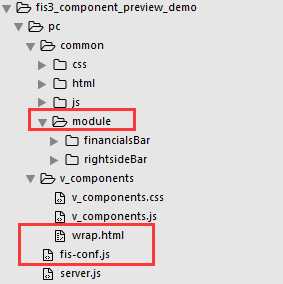
其中wrap对应的文件wrap.html作用非常重要。后面四个参数moduleXXXInstead对应的值必须在wrap.html中能够找到,然后使用插件拼装好的数据来替换他。wrap.html源码如下
<!DOCTYPE html> <html> <head> <title>组件可视化</title> ... </head> <body> <div class="left-side">instead of modules</div> <div class="right-side"> <div class="right-side-top">instead of view htmls</div> <div class="right-side-bottom">instead of commnets</div> </div> ... <script type="text/javascript">instead of js</script> </body> </html>
最终执行fis后上面黑色粗体文字全部被替换

<!DOCTYPE html> <html> <head> <title>组件可视化</title> ... </head> <body> <div class="left-side"><div data-mod="financialsBar">financialsBar</div><div data-mod="financialsSmlBar">financialsSmlBar</div><div data-mod="rightsideBar">rightsideBar</div></div> <div class="right-side"> <div class="right-side-top"><div data-mod="financialsBar"> <!-- 新手 --> <div class="js-financialsBar1"></div> <!-- 活期 --> <div class="js-financialsBar2"></div> <!-- 定期 --> <div class="js-financialsBar3"></div> </div><div data-mod="financialsSmlBar"> <!-- 定期理财 --> <div class="js-financialsSmlBar1"></div> <!-- 债权转让 --> <div class="js-financialsSmlBar2"></div> </div><div data-mod="rightsideBar"> <div class="js-rightsideBar"></div> </div></div> <div class="right-side-bottom"><div data-mod="financialsBar"><div >样例:<div>html:<br> <!-- 新手 --><br> <div class="js-financialsBar1"></div><br> <!-- 活期 --><br> <div class="js-financialsBar2"></div......</div> </div> ... <script type="text/javascript">var financialsBar = require(‘common/module/financialsBar/financialsBar‘); new financialsBar($(‘.js-financialsBar1‘), { "type": "novice", "bdid": 1, "name": "农优宝A1231213", "title": "新手专享", "term": 1, "annualrate": 0.09, "interestRaise": 0.005, "surplusAmount": 30000, "projectScale": 50000, "status": "RZZ", "packStatus": "QGZ", "releaseDate": 425132121, "nowDate": 45641231321, "surplusBuyCount":1, ‘productType‘: ‘NYB‘, ‘delayTime‘: 0 }); ... </script> </body> </html>
来自相同的组件的DOM节点的属性值data-mod相同。
fis-conf.js的配置片段
.match(‘::package‘, {
prepackager: fis.plugin(‘component-preview‘,{
wrap: ‘/v_components/wrap.html‘,//组件可视化原型文件,用来包裹组件可视化代码
url: ‘/v_components.html‘, //目标文件
COMPath: ‘/common/module‘,//组件集合目录
moduleListInstead: ‘instead of modules‘,//使用模块列表节点替换当前文本
moduleViewInstead: ‘instead of view htmls‘,//使用模块视图列表节点替换当前文本
moduleCommentsInstead: ‘instead of commnets‘,//使用模块注释列表节点替换当前文本
moduleJsInstead: ‘instead of js‘//使用js脚本节点替换当前文本
})
})
更详细的demo查看fis3_component_preview_demo
最终效果同第一阶段的组件可视化效果一样
实现原理:
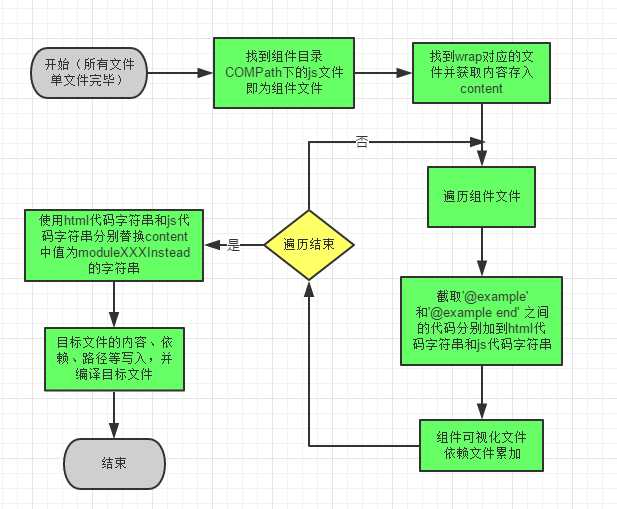
完整的插件源码查看fis3-prepackager-component-preview
如果觉得本文不错,请点击右下方【推荐】!
标签:
原文地址:http://www.cnblogs.com/chuaWeb/p/component_preview.html